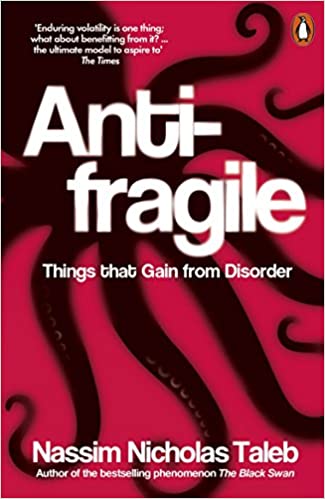Antifragile: Things That Gain from Disorder – Nassim Nicholas Taleb

“Antifragile: Things That Gain from Disorder” was published in 2012 and became a bestseller. In the book, Taleb argues that certain systems, processes, and things can become stronger and more resilient when subjected to stressors and volatility, rather than breaking down or becoming weaker. He calls this property “antifragility” and suggests that it is an important concept for understanding complex systems and adapting to an unpredictable world.
Antifragility is the opposite of fragility
Antifragility is not the same as robustness or resilience, which refer to a system’s ability to resist damage or recover from it. Rather, antifragile systems actually benefit from stressors and volatility.
For example, the human body becomes stronger after being exposed to mild stressors, like exercise, while becoming weaker through sedentary living. Understanding this concept is critical for building systems that can thrive in an unpredictable world.
Decentralization can make systems more antifragile
Centralized systems are often more fragile than decentralized ones because they are vulnerable to a single point of failure. Decentralization distributes power and responsibility across multiple nodes, making the system more resilient to shocks and disruptions.
Skin in the game is important
People are more likely to act responsibly and make good decisions when they have “skin in the game,” that is, when they have something to lose if things go wrong. This principle applies to both individuals and organizations and can help align incentives and promote responsible behavior.
Antifragility requires a mindset shift
Becoming more antifragile requires a fundamental shift in mindset. Rather than trying to control and predict the future, we must learn to embrace uncertainty and randomness. We must also be willing to experiment, learn from failure, and adapt our systems accordingly. By doing so, we can build systems that not only survive, but thrive in a rapidly changing world.
Beware of the narrative fallacy
Humans are wired to create stories to make sense of the world around us. However, this can lead to a false sense of certainty and a neglect of alternative explanations. We should be aware of this tendency and approach information with a critical eye, avoiding the temptation to create a narrative that may not be accurate.
Embrace randomness and uncertainty
In a complex and rapidly changing world, trying to predict the future is a futile exercise. Instead, we should embrace uncertainty and learn to live with randomness. This means building systems that are adaptable and can respond to changing circumstances, rather than relying on rigid plans or models.
Optionality is key to antifragility
Building optionality into systems is a powerful way to make them more antifragile. This means creating multiple paths for future development rather than committing to a single course of action. This approach allows us to be flexible and adapt to changing circumstances.
Avoid the tyranny of the collective
Collective decision-making can lead to conformity and groupthink, which can be dangerous in an unpredictable world. Instead, we should encourage diversity of thought and dissenting voices. This can help to surface alternative perspectives and avoid blind spots.
Avoid over-engineering and over-optimization
When we try to engineer systems to be perfect or optimize them to the extreme, we often end up creating fragile systems that are vulnerable to unexpected events. Instead, we should strive for simplicity and redundancy, which can make systems more robust.
Trial and error is a powerful way to learn
The best way to learn in a complex and uncertain world is through trial and error. Experimentation allows us to discover what works and what doesn’t, and to adapt our systems accordingly. However, this requires a willingness to accept failure and learn from it.

